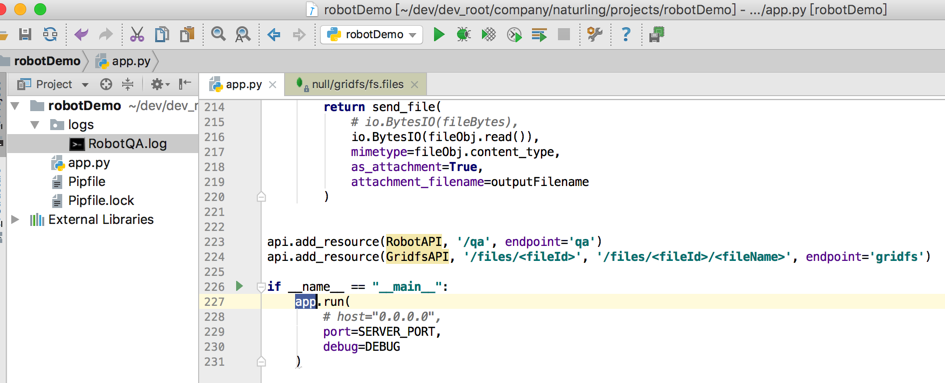折腾:
【已解决】Mac本地用gunicorn部署启动Flask应用
期间,参考:
Deployment Options — Flask Documentation (0.12)
对于示例:
<code>gunicorn -w 4 -b 127.0.0.1:4000 myproject:app </code>
中的最后的myproject:app是什么意思,需要去搞懂
通过之前看到的help中:
<code>➜ robotDemo gunicorn --help usage: gunicorn [OPTIONS] [APP_MODULE] optional arguments: -h, --help show this help message and exit -v, --version show program's version number and exit -c CONFIG, --config CONFIG The Gunicorn config file. [None] -b ADDRESS, --bind ADDRESS The socket to bind. [['127.0.0.1:8000']] --backlog INT The maximum number of pending connections. [2048] -w INT, --workers INT The number of worker processes for handling requests. [1] -k STRING, --worker-class STRING The type of workers to use. [sync] --threads INT The number of worker threads for handling requests. [1] --worker-connections INT The maximum number of simultaneous clients. [1000] --max-requests INT The maximum number of requests a worker will process before restarting. [0] --max-requests-jitter INT The maximum jitter to add to the *max_requests* setting. [0] -t INT, --timeout INT Workers silent for more than this many seconds are killed and restarted. [30] --graceful-timeout INT Timeout for graceful workers restart. [30] --keep-alive INT The number of seconds to wait for requests on a Keep- Alive connection. [2] --limit-request-line INT The maximum size of HTTP request line in bytes. [4094] --limit-request-fields INT Limit the number of HTTP headers fields in a request. [100] --limit-request-field_size INT Limit the allowed size of an HTTP request header field. [8190] --reload Restart workers when code changes. [False] --reload-engine STRING The implementation that should be used to power :ref:`reload`. [auto] --spew Install a trace function that spews every line executed by the server. [False] --check-config Check the configuration. [False] --preload Load application code before the worker processes are forked. [False] --no-sendfile Disables the use of ``sendfile()``. [None] --chdir CHDIR Chdir to specified directory before apps loading. [/Us ers/crifan/dev/dev_root/company/naturling/projects/rob otDemo] -D, --daemon Daemonize the Gunicorn process. [False] -e ENV, --env ENV Set environment variable (key=value). [[]] -p FILE, --pid FILE A filename to use for the PID file. [None] --worker-tmp-dir DIR A directory to use for the worker heartbeat temporary file. [None] -u USER, --user USER Switch worker processes to run as this user. [501] -g GROUP, --group GROUP Switch worker process to run as this group. [20] -m INT, --umask INT A bit mask for the file mode on files written by Gunicorn. [0] --initgroups If true, set the worker process's group access list with all of the [False] --forwarded-allow-ips STRING Front-end's IPs from which allowed to handle set secure headers. [127.0.0.1] --access-logfile FILE The Access log file to write to. [None] --access-logformat STRING The access log format. [%(h)s %(l)s %(u)s %(t)s "%(r)s" %(s)s %(b)s "%(f)s" "%(a)s"] --error-logfile FILE, --log-file FILE The Error log file to write to. [-] --log-level LEVEL The granularity of Error log outputs. [info] --capture-output Redirect stdout/stderr to Error log. [False] --logger-class STRING The logger you want to use to log events in Gunicorn. [gunicorn.glogging.Logger] --log-config FILE The log config file to use. [None] --log-syslog-to SYSLOG_ADDR Address to send syslog messages. [unix:///var/run/syslog] --log-syslog Send *Gunicorn* logs to syslog. [False] --log-syslog-prefix SYSLOG_PREFIX Makes Gunicorn use the parameter as program-name in the syslog entries. [None] --log-syslog-facility SYSLOG_FACILITY Syslog facility name [user] -R, --enable-stdio-inheritance Enable stdio inheritance. [False] --statsd-host STATSD_ADDR ``host:port`` of the statsd server to log to. [None] --statsd-prefix STATSD_PREFIX Prefix to use when emitting statsd metrics (a trailing ``.`` is added, [] -n STRING, --name STRING A base to use with setproctitle for process naming. [None] --pythonpath STRING A comma-separated list of directories to add to the Python path. [None] --paste STRING, --paster STRING Load a PasteDeploy config file. The argument may contain a ``#`` [None] --proxy-protocol Enable detect PROXY protocol (PROXY mode). [False] --proxy-allow-from PROXY_ALLOW_IPS Front-end's IPs from which allowed accept proxy requests (comma separate). [127.0.0.1] --keyfile FILE SSL key file [None] --certfile FILE SSL certificate file [None] --ssl-version SSL_VERSION SSL version to use (see stdlib ssl module's) [_SSLMethod.PROTOCOL_TLS] --cert-reqs CERT_REQS Whether client certificate is required (see stdlib ssl module's) [VerifyMode.CERT_NONE] --ca-certs FILE CA certificates file [None] --suppress-ragged-eofs Suppress ragged EOFs (see stdlib ssl module's) [True] --do-handshake-on-connect Whether to perform SSL handshake on socket connect (see stdlib ssl module's) [False] --ciphers CIPHERS Ciphers to use (see stdlib ssl module's) [TLSv1] --paste-global CONF Set a PasteDeploy global config variable in ``key=value`` form. [[]] </code>
感觉属于:
usage: gunicorn [OPTIONS] [APP_MODULE]
中的APP_MODULE
估计是:
python文件名中的flask的application名
而此处:
<code>➜ robotDemo pwd /Users/crifan/dev/dev_root/company/naturling/projects/robotDemo ➜ robotDemo ll total 48 -rw-r--r-- 1 crifan staff 212B 4 20 10:15 Pipfile -rw-r--r-- 1 crifan staff 7.8K 4 20 10:16 Pipfile.lock -rw-r--r-- 1 crifan staff 8.3K 4 19 21:40 app.py drwxr-xr-x 3 crifan staff 96B 4 18 17:43 logs </code>
python文件是:
app.py,所以是:
app:xxx
再去找xxx:


此处的Flask的实例的变量名是app
所以,此处是
app:app
参考:
https://www.cnblogs.com/Ray-liang/p/4837850.html
更加确定我的猜测。
gunicorn 参数解释
“运行gunicorn:
$ gunicorn [OPTIONS] 模块名:变量名
模块名是python文件名,可以是完整的路径+python文件名;变量名是python文件中可调用的WSGI(Web Server Gateway )”
【总结】
gunicorn的示例:
<code>gunicorn -w 4 -b 127.0.0.1:4000 myproject:app </code>
中的:
myproject:app
的含义是:
是属于
<code>gunicorn --help usage: gunicorn [OPTIONS] [APP_MODULE] </code>
中的APP_MODULE
APP_MODULE的格式是:
python文件名:WSGI的应用的变量名
(此处)==python文件名:Flask的实例的变量名
比如对于:
yourPythonName.py
中有:
<code>flaskInstanceVariable = Flask(__name__) </code>
if __name__ == “__main__”:
flaskInstanceVariable.run()
的话,则是:
yourPythonName:flaskInstanceVariable
【后记】
Gunicorn快速入门 – Arts&Crafts – 博客园
“APP_MODULE 指定 wsgi application文件,书写格式 $(MODULE_NAME):$(VARIABLE_NAME)。其中 module_name用来制定将要运行的 wsgi application文件,可是一个完整的点缀名。比如当前目录 myapp 目录下有个 Python 包 gunicorn_app, gunicorn_app包下有一个wsgi application文件 test.py 则 module_name可以直接写成 gunicorn_app.test。viriable_name表示在 module_name 文件中要调用的对象(是一个WSGI callable, 可以是一个函数,类详情参看WSGI规格说明书)名。”
转载请注明:在路上 » 【已解决】部署Flask的gunicorn的最后一个参数的含义